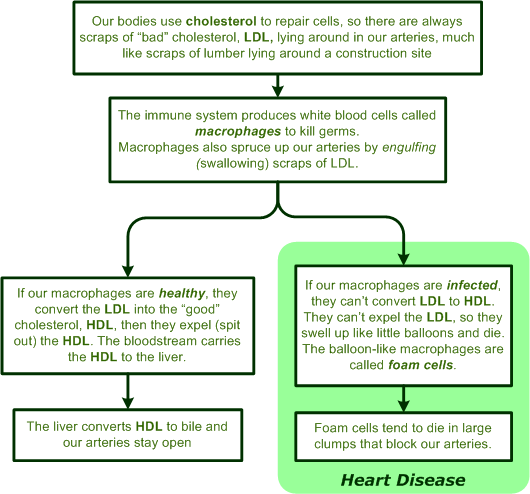Cholesterol, Foam Cells, and Blocked Arteries
Television ads would have us believe that heart disease is caused by evil blobs of cholesterol creeping though our bloodstreams looking for arteries to clog. Not so. The drawing shows how cholesterol gets into our arteries.

Macrophages are often infected with germs that prevent them from processing cholesterol properly. Two of these germs, Chlamydophila pneumoniae and cytomegalovirus, are extremely common--about half of all adults are chronically infected with one or the other, and nearly everyone over the age of sixty is infected with both of them. When we are infected with either of these germs, or by germs like them, we are likely to develop heart disease.
A reasonable question. A reasonable question at this point might be: "If most people are infected with Chlamydophila and⁄or cytomegalovirus, why don't most people have heart disease?"
There are several answers to this question, but I think the best is this: Nearly all adults have some degree of heart disease, but most of them will die from something else before their heart disease becomes a problem.
More information on infections and heart disease
Foam cells and heart disease are discussed in Chapters 4 and 5 of The Potbelly Syndrome. More information can be obtained from the papers referenced below.
Vahdat K, Jafari SM, Pazoki R, Nabipour I. Concurrent increased high sensitivity C-reactive protein and chronic infections are associated with coronary artery disease: a population-based study. Indian J Med Sci. 2007 Mar;61(3):135-43.
Guiglia R, Campisi G, Pizzo G, Lo Muzio L, Falaschini S, Gallo PD, D'Angelo M. [Periodontal disease and cardiovascular disease: correlation or simple coincidence?]Recenti Prog Med. 2007 Jul-Aug;98(7-8):426-32. Review. Italian.
Mahmoudi M, Curzen N, Gallagher PJ. Atherogenesis: the role of inflammation and infection. Histopathology. 2007 Apr;50(5):535-46. Review.
Higuchi ML, Santos MH, Roggerio A, Kawakami JT, Bezerra HG, Canzian M. A role for archaeal organisms in development of atherosclerotic vulnerable plaques and myxoid matrices. Clinics. 2006 Oct;61(5):473-8.
Clancy R, Ren Z, Pang G, Fletcher P, D'Este C. Chronic Chlamydia pneumoniae infection may promote coronary artery disease in humans through enhancing secretion of interleukin-4. Clin Exp Immunol. 2006 Nov;146(2):197-202.
Cao F, Castrillo A, Tontonoz P, Re F, Byrne GI. Chlamydia pneumoniae--induced macrophage foam cell formation is mediated by Toll-like receptor 2. Infect Immun. 2007 Feb;75(2):753-9. Epub 2006 Dec 4.
Paoletti R, Gotto AM Jr, Hajjar DP. Inflammation in atherosclerosis and implications for therapy. Circulation. 2004 Jun 15;109(23 Suppl 1):III20-6. Review.
Ewald PW, Cochran GM. Chlamydia pneumoniae and cardiovascular disease: an evolutionary perspective on infectious causation and antibiotic treatment. J Infect Dis. 2000 Jun;181 Suppl 3:S394-401. Review.
Likhoded VG, Martynova VR. [Role of Chlamydia pneumoniae in the etiology of atherosclerosis] Zh Mikrobiol Epidemiol Immunobiol. 2000 Jul-Aug;(4 Suppl):117-21. Review. Russian.
Zhou YF, Guetta E, Yu ZX, Finkel T, Epstein SE. Human cytomegalovirus increases modified low density lipoprotein uptake and scavenger receptor mRNA expression in vascular smooth muscle cells. J Clin Invest. 1996 Nov 1;98(9):2129-38.
